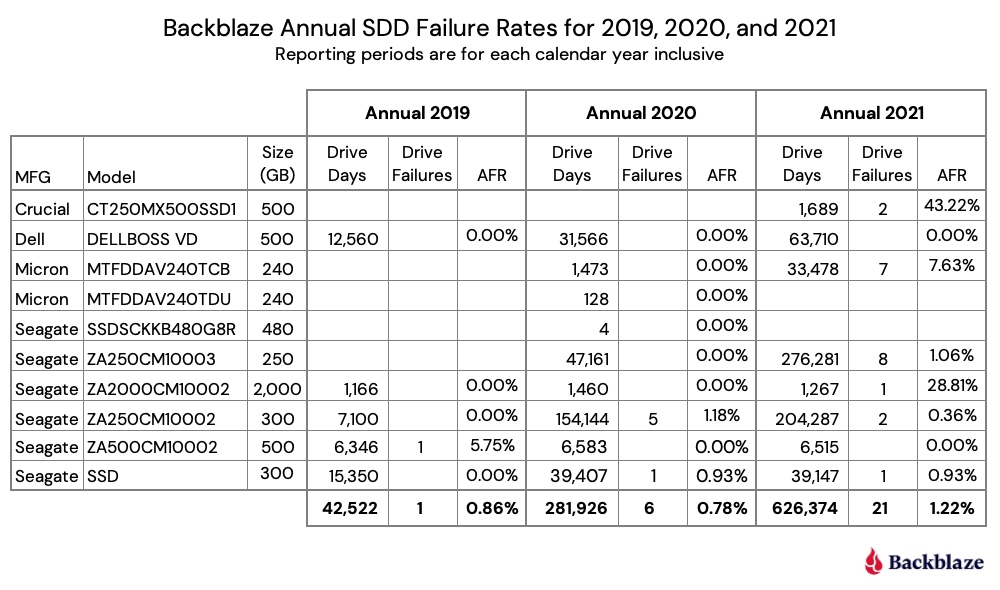 [German]Solid state disks (SSDs) are just as reliable as hard disks (HDDs). That's the insight in a nutshell from cloud provider Backblaze's 2021 Drive Status Report. The provider has been using SSDs since Q4 2018 and had the number of 2,200 SSDs in use in 2021.
[German]Solid state disks (SSDs) are just as reliable as hard disks (HDDs). That's the insight in a nutshell from cloud provider Backblaze's 2021 Drive Status Report. The provider has been using SSDs since Q4 2018 and had the number of 2,200 SSDs in use in 2021.
Data storage devices can and does fail all the time. Broken hard drives or SSDs have probably been experienced by everyone involved in the field. However, many users still have the feeling that solid state disks (SSDs) break down faster. It is interesting to see what the cloud provider Backblaze has to say on the subject. I came across a corresponding article here the other day.
Backblaze Drive Status-Report 2021
On February 1, 2022, Backblaze published its Backblaze Drive Stats for 2021 report, and then followed it up with a complementary blog post, The SSD Edition: 2021 Drive Stats Review, on March 3, 2022. The latter post is purely about SSDs, while the 2021 report was about hard drives.
As of December 31, 2021, Backblaze had 2,200 SSDs in use, with SSDs deployed since Q4 2018. Since Q4 2018, SSDs have been installed on all new storage servers and on all systems with failed HDD boot drives. The boot drives in the backblace environment are not only used to boot the storage servers. The SSDs also store log files and temporary files generated by the storage server. Every day, a boot drive reads, writes, and deletes files depending on the activity of the storage server itself.

The table above gives the failure rates of SSDs across different models in 2019 to 2021. The AFR value (failure rate) is calculated according to the following formula:
AFR = (drive failures / (drive days / 365)) * 100
In the table above, two SSD models stand out with extremely high failure rates: The model from Crucial: CT250MX500SSD1 (43.22%) and the model from Seagate: ZA2000CM10002 (28.81%). However, we should not overestimate these data, because in the case of the Crucial there are only 20 drives installed in December 2021. In the case of the Seagate hard drive, there were only four drives, one of which failed in early 2021. In both cases, the AFR is based on very little data, resulting in a very wide confidence interval, Backblaze writes.
The evaluation across all SSD drives is interesting. The cumulative AFR was 1.07% for all SSD drives in the fourth quarter of 2021. In comparison, the cumulative AFR (during lifetime) for the HDDs used was 1.40% (according to the 2021 Drive Statistics report). So, the failure rates are in the same order of magnitude, but the two groups (SSDs and HDDs) are not at the same point in their lifecycle.
However, Backblaze warns that the total number of SSDs in use is still relatively small. Thus, the evaluation is not yet set in stone, but gives hints. Andy Klein, the author of the evaluation writes about this: "The more data we have, the better, and the older the SSDs get, the more attentive we will be to see how long they last. For HDDs, we have a lot of data on this topic, but for SDDs, we're still learning."
But it's interesting to note that the three older SSD models Backblaze has in use had a cumulative failure rate of less than 1 percent in 2021. The cumulative AFR for all SSD drives was 1.07 percent. At the very least, a trend can be seen: SSDs do not appear to be worse than HDDs in terms of reliability. The details may be read in the linked Backblaze document here.



